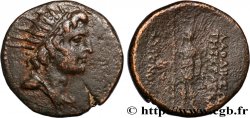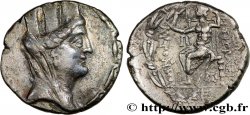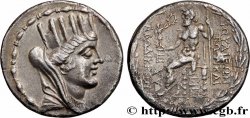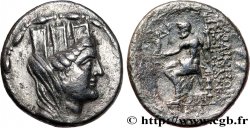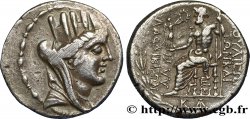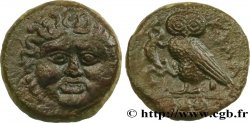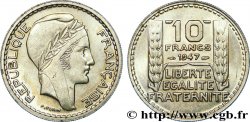v51_0249 - SIRIA - SELEUCIA E PIERIA - LAODICEA Tétradrachme stéphanophore
MONNAIES 51 (2011)
Начальная цена : 750.00 €
Назначить цену : 1 200.00 €
непроданный лот
Начальная цена : 750.00 €
Назначить цену : 1 200.00 €
непроданный лот
Тип Tétradrachme stéphanophore
Дата: An 19
Монетный двор / Город: Syrie, Séleucie et Piérie, Laodicée
Металл: silver
Диаметр: 25,5 mm
Ориентация осей монеты: 11 h.
Вес: 14,81 g.
Редкость: R3
Комментарии о состоянии
Exemplaire sur un petit flan bien centré des deux côtés un peu court sur les couronnes. Très beau portrait, bien venu à la frappe, de haut relief. Joli revers avec un Zeus équilibré de haut relief, de style fin, bien venu à la frappe. Très belle patine de collection ancienne avec des reflets mordorés. Patine légèrement granuleuse
Ссылки в каталоге: :
Происхождение:
Cet exemplaire provient du stock de Roland Barthold, août 1985
Лицевая сторона
Аверс: легенда: ANÉPIGRAPHE.
Аверс: описание: Buste de Tyché à droite, tourelé, voilé et drapé, entouré de la stemma.
Обратная сторона
Реверс: Описание: Zeus nicéphore trônant à gauche, tenant une Niké de la main droite et un sceptre long de la gauche ; le tout dans une couronne de laurier.
Реверс: легенда: LAODIKEWN/ THS IERAS KAI/ AUTONOMOU/ QI/HI/ (PAU)/ KA
Реверс: перевод: (de Laodicée, la sainte et autonome).
Комментарий
Même coin de droit que l’exemplaire du Cabinet des médailles de Bruxelles (collection de Hirsch 1730) pour l’an 18 (64-63 avant J.-C.) (Morkholm, 11a, pl. 15/16) avec un début de cassure de coin perceptible dans la couronne murale de Tyché au droit et une marque bien particulière sur la joue. Le coin de droit se détériore progressivement par réemploi successif plusieurs années de suite. Cette date était inédite et manquait à l’article de Morkholm. De plus l’an 19 est regravé avec le thêta refait sur l’heta (9 sur 8). Nous avons un exemplaire de l’an 17, 18 et 20 de même coin de droit que notre exemplaire (Morkholm 10a, 11a et 12, pl. 15, n° 15, 16 et 17). Ce type est maintenant signalé dans l’ouvrage de Hoover.
Same obverse die as the example from the Cabinet of Medals of Brussels (Hirsch collection 1730) for the year 18 (64-63 BC) (Morkholm, 11a, pl. 15/16) with the beginning of a die break visible in the mural crown of Tyche on the obverse and a very particular mark on the cheek. The obverse die gradually deteriorates through successive reuse over several years. This date was unpublished and was missing from the Morkholm article. In addition, the year 19 is re-engraved with the theta redone on the heta (9 out of 8). We have a example from the year 17, 18 and 20 with the same obverse die as our example (Morkholm 10a, 11a and 12, pl. 15, nos. 15, 16 and 17). This type is now noted in Hoover's work
Same obverse die as the example from the Cabinet of Medals of Brussels (Hirsch collection 1730) for the year 18 (64-63 BC) (Morkholm, 11a, pl. 15/16) with the beginning of a die break visible in the mural crown of Tyche on the obverse and a very particular mark on the cheek. The obverse die gradually deteriorates through successive reuse over several years. This date was unpublished and was missing from the Morkholm article. In addition, the year 19 is re-engraved with the theta redone on the heta (9 out of 8). We have a example from the year 17, 18 and 20 with the same obverse die as our example (Morkholm 10a, 11a and 12, pl. 15, nos. 15, 16 and 17). This type is now noted in Hoover's work







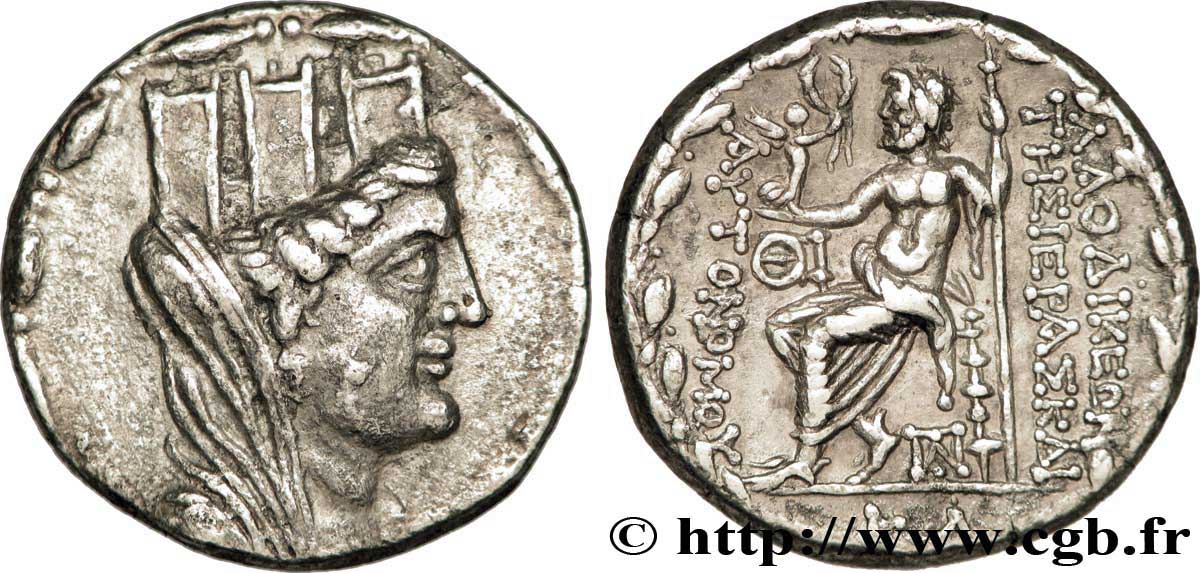
 Cообщить об ошибке
Cообщить об ошибке Распечатать страницу
Распечатать страницу Отправить мой выбор
Отправить мой выбор Задать вопрос
Задать вопрос Consign / sell
Consign / sell
 Информация
Информация